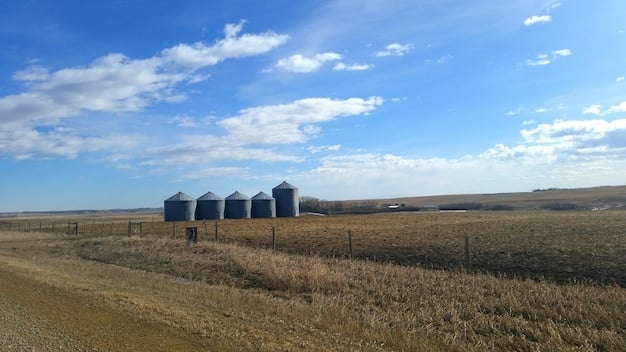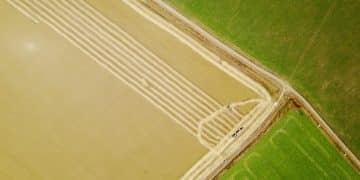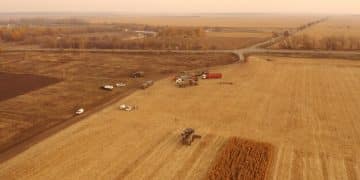US Grain Storage Capacity: Preparing for the 2025 Harvest

US grain storage capacity is under scrutiny as projections for the 2025 harvest suggest a potentially record-breaking yield; assessing current infrastructure and identifying necessary improvements are crucial to avoid bottlenecks and economic losses for American farmers.
As we look ahead to 2025, the agricultural sector in the United States is buzzing with anticipation regarding the projected bumper harvest. However, this excitement is tempered by a critical question: Is the US grain storage capacity adequate to handle the expected surplus? This looming challenge necessitates a comprehensive evaluation of our storage infrastructure and proactive measures to ensure we are prepared.
Evaluating US Grain Storage Capacity for 2025
The agricultural landscape of the United States is constantly evolving, with advancements in farming technology and practices leading to increased yields. As we approach 2025, projections indicate a significant surge in grain production. This impending surge puts the spotlight on our existing grain storage capacity and its ability to cope with the anticipated bumper harvest.
Understanding the current state of grain storage in the US requires a detailed assessment of various factors, including the types of storage facilities available, their geographical distribution, and their overall capacity. Analyzing these aspects will provide a clearer picture of our preparedness for the challenges and opportunities that lie ahead.
Types of Grain Storage Facilities
Grain storage facilities come in various forms, each with its own advantages and limitations. The most common types include:
- On-Farm Storage: Silos and bins located on individual farms, offering farmers greater control over their grain and allowing for staggered marketing.
- Commercial Elevators: Large-scale facilities located in strategic transportation hubs, providing storage and handling services for multiple farmers.
- Cooperative Storage: Facilities owned and operated by farmer cooperatives, offering storage solutions and marketing support to their members.
- Temporary Storage: Structures like grain bags or piles covered with tarpaulins, used to handle short-term surpluses when permanent storage is unavailable.
The distribution of these storage facilities across the US is not uniform, with concentrations in major grain-producing states like Iowa, Illinois, and Kansas. Understanding this geographical distribution is crucial for identifying potential bottlenecks in the storage and transportation network.

In conclusion, a thorough evaluation of the types and distribution of grain storage facilities is essential to gauge the nation’s capacity to handle the projected bumper harvest in 2025. This assessment will inform strategies for optimizing storage solutions and mitigating potential risks.
Projected Grain Harvest in 2025: What to Expect
Forecasting the size and composition of the 2025 grain harvest is a complex undertaking, influenced by factors ranging from weather patterns to technological advancements in agriculture. Industry analysts and government agencies alike dedicate considerable resources to developing these projections, providing valuable insights for farmers, policymakers, and the broader agricultural community.
Understanding these projections is crucial for assessing the demand on grain storage capacity and identifying potential challenges in the supply chain. Accurate forecasts enable stakeholders to make informed decisions about storage, transportation, and marketing strategies.
Key Factors Influencing Harvest Projections
Several key factors play a significant role in determining the size and composition of the annual grain harvest. These include:
- Weather Conditions: Rainfall, temperature, and extreme weather events like droughts or floods can have a profound impact on crop yields.
- Technological Advancements: Innovations in seed technology, precision farming techniques, and irrigation systems contribute to increased productivity.
- Government Policies: Farm subsidies, trade agreements, and environmental regulations can influence planting decisions and overall production levels.
- Market Demand: Domestic and international demand for different types of grain can affect planting choices and ultimately the composition of the harvest.
Considering these factors, projections for the 2025 harvest suggest a significant increase in overall grain production, particularly for corn and soybeans. This increase is largely attributed to favorable weather conditions and the continued adoption of high-yielding crop varieties.
In summary, the projected bumper harvest in 2025 underscores the importance of proactive planning and investment in grain storage infrastructure. By understanding the factors driving these projections, stakeholders can better prepare for the challenges and opportunities that lie ahead.
Regional Variations in Storage Needs
While the national grain storage capacity is a critical concern, it is equally important to consider the regional variations in storage needs across the United States. Different regions specialize in the production of different types of grain, and their storage requirements can vary significantly based on the volume and characteristics of their crops.
Understanding these regional variations is essential for ensuring that storage capacity is adequate in all areas of the country. It also allows for targeted investments and improvements in infrastructure to address specific needs.
Identifying Regional Storage Hotspots
Certain regions of the US are particularly vulnerable to storage shortages, especially during bumper harvest years. These “hotspots” typically coincide with major grain-producing areas and regions with limited storage infrastructure.
Some of the key regional storage hotspots include:
- The Corn Belt: States like Iowa, Illinois, and Nebraska, which account for a significant portion of the nation’s corn production, often face storage challenges during harvest season.
- The Wheat Belt: States like Kansas, Oklahoma, and North Dakota, where wheat is a primary crop, require substantial storage capacity to handle the annual wheat harvest.
- The Soybean Belt: States like Minnesota, Indiana, and Ohio, which are major soybean producers, also experience high demand for storage space.

Factors such as transportation infrastructure, local market conditions, and the availability of alternative storage options can also influence regional storage needs. For example, regions with limited access to rail or barge transportation may face greater storage challenges than those with well-developed transportation networks.
In conclusion, addressing regional variations in storage needs is crucial for ensuring the overall resilience of the US grain storage system. Targeted investments in infrastructure and improved coordination between stakeholders can help mitigate potential storage shortages and support the success of American farmers.
Impact of Storage Shortages on the Market
Inadequate grain storage capacity can have significant consequences for the agricultural market, affecting prices, farmer profitability, and the overall efficiency of the supply chain. Storage shortages can lead to a cascade of negative effects, impacting various stakeholders in the industry.
Understanding the potential impact of storage shortages is essential for justifying investments in infrastructure and implementing strategies to mitigate these risks. Proactive measures can help stabilize the market and ensure a fair return for farmers.
Economic Consequences of Insufficient Storage
The economic consequences of grain storage shortages can be far-reaching, affecting:
- Price Volatility: When storage capacity is limited, farmers may be forced to sell their grain immediately after harvest, leading to a glut in the market and depressed prices.
- Reduced Farmer Profitability: Lower prices can significantly reduce farmer income, making it difficult for them to cover their production costs and invest in their operations.
- Supply Chain Inefficiencies: Storage shortages can disrupt the flow of grain from farms to processors and consumers, leading to delays, increased transportation costs, and potential spoilage.
Furthermore, storage shortages can create opportunities for market manipulation and speculation, as traders and processors may exploit the limited supply to drive up prices. This can further exacerbate price volatility and harm farmers.
In summary, the potential economic consequences of grain storage shortages underscore the importance of proactive planning and investment in infrastructure. By ensuring adequate storage capacity, the US can protect its farmers, stabilize its agricultural market, and maintain a reliable food supply.
Strategies for Expanding Storage Capacity
To address the challenges posed by the projected bumper harvest in 2025, it is essential to explore various strategies for expanding grain storage capacity across the United States. These strategies can range from investing in new infrastructure to optimizing the use of existing facilities.
A multifaceted approach that combines both short-term and long-term solutions is likely to be the most effective way to ensure adequate storage capacity and mitigate potential risks.
Innovative Storage Solutions
Beyond traditional silos and bins, several innovative storage solutions are emerging that can help expand capacity and improve efficiency. These include:
- Grain Bags: Large, flexible bags that can be used to store grain on-site, providing a cost-effective and temporary storage solution.
- Vertical Silos: Tall, slender silos that maximize storage capacity in a small footprint, ideal for urban or space-constrained areas.
- Climate-Controlled Storage: Facilities that maintain optimal temperature and humidity levels to preserve grain quality and extend shelf life.
In addition to these physical storage solutions, technological advancements in grain monitoring and management can also contribute to increased efficiency. Remote sensing, data analytics, and automation can help optimize storage conditions, reduce spoilage, and improve overall inventory management.
In conclusion, expanding grain storage capacity requires a combination of traditional and innovative solutions. By investing in new infrastructure, optimizing existing facilities, and embracing technological advancements, the US can ensure that it is well-prepared for the challenges and opportunities of the future.
Policy and Investment Recommendations
Addressing the challenges related to US grain storage capacity requires a concerted effort from policymakers, industry stakeholders, and investors. Strategic policy decisions and targeted investments can play a crucial role in ensuring that the nation is well-prepared for future harvests.
A comprehensive approach that considers both short-term and long-term needs is essential for creating a sustainable and resilient grain storage system.
Government Initiatives and Incentives
Government initiatives and incentives can provide valuable support for expanding grain storage capacity. These may include:
- Tax Credits: Offering tax credits to farmers and businesses that invest in new or upgraded storage facilities.
- Loan Programs: Providing low-interest loans to finance storage construction and expansion projects.
- Research and Development Grants: Funding research into innovative storage technologies and best practices.
Furthermore, government agencies can play a role in coordinating efforts between different stakeholders, facilitating the sharing of information and resources, and promoting the adoption of best practices. Public-private partnerships can also be an effective way to leverage resources and expertise to achieve common goals.
In summary, strategic policy decisions and targeted investments are essential for ensuring that the US has adequate grain storage capacity to meet the challenges of the future. By working together, policymakers, industry stakeholders, and investors can create a sustainable and resilient agricultural system that benefits all Americans.
| Key Point | Brief Description |
|---|---|
| 🌾 Expected Harvest 2025 | A large grain yield is expected in 2025. Evaluate whether current infrastructure can meet the amount that is produced. |
| 💰 Economic Impact | Storage issues could reduce prices, lower farmer revenue, and affect the food chain. |
| 🏦 Government Support | Tax benefits and loans for facility updates might facilitate increasing storage. |
| 📦 Storage Solutions | Grain bags, vertical silos, are all innovative alternative solutions for grain storage facilities. |
FAQ
▼
The main types include on-farm storage, commercial elevators, cooperative storage, and temporary storage solutions like grain bags. Each serves different needs based on scale and control required.
▼
Different regions specialize in different grains. Understanding these variations ensures that storage capacity aligns with local production, avoiding shortages in key agricultural zones.
▼
Shortages can cause price volatility, reduce farmer profits, and disrupt the grain supply chain, affecting both producers and consumers by creating market inefficiencies.
▼
Grain bags and vertical silos are innovative, alongside climate-controlled storage, which helps extend grain life and maintain quality. These options maximize space and preservation efficiency.
▼
Tax credits for storage upgrades and low-interest loans provide financial incentives. Government-funded R&D enhances storage efficiency and promotes best practices through public-private efforts.
Conclusion
In conclusion, addressing the US grain storage capacity in anticipation of the 2025 bumper harvest requires a multifaceted approach encompassing infrastructural improvements, policy support, and innovative solutions. By proactively evaluating and expanding our storage capabilities, we can ensure market stability, protect farmer profitability, and secure a reliable food supply for the nation.





